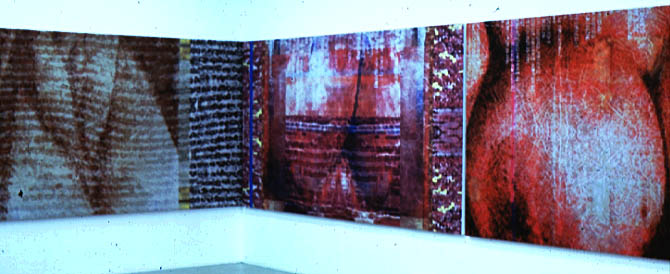
Joseph Nechvatal: ec-satyricOn 2000@ UCU Gallery
When we hear or read the term “satyricon,” there is he inclination to think of the famous film by the Italian auteur Federico Fellini. What the artist Joseph Nechvatal has done is apply the erotic abandon of this film to another structure. The medium is not film but painting or, more precisely, ink-jet painting as programmed by a computer. There is another aspect to the work that precedes the actual software/industrial production of the work. Nechvatal has worked with an overlay of imagery, mostly from erotic sources, in order to create an intense palimpsest of libidinal energy in he form of a wraparound pictorial space. The term “composition” does not seem appropriate to the ideology that stands behind this extraordinary new painting.
Many observers are unaware of the fact that Nechvatal was one of the first artist to work with computers and painting. I am not referring to graphic imagery, but to the ideas that are associated with advanced painting since mid-century. As early as 1986, he pursued the notion that the act of painting was less important than the pictorial image that informed the painting. Nechvatal understood that in order to come to terms with a pictorial idea it was necessary to grasp the history of painting, specifically French painting that had dominated the transition from the Salon into Impressionism and finally into the Modern era. He spent many an afternoon at the Louvre studying the great paintings of Poussin, David, Ingres, Gericault and Delacroix. Through his investigation, Nechvatal discovered a pictorial structure that led all the way to Pollock and beyond.
In fact, Nechvatal;l wanted to become the “beyond” -- to go beyond Pollock and the concept of all-over composition. The computer offered the necessary tool to accomplish this feat. The overlay of imagery, both representational and literal, became the direction of Nechvatal involvement with software and its viral inclinations during the mid-80s.
It is amazing that curators at MoMA and the Whitney, let alone the Guggenheim, have not recognized this fact. While they elevate the importance of artists as Matthew Barney and Larry Pittman, they ignore the earlier, prerequisite cyber-forms of Nechvatal. Nevertheless, “ec-satyric0n 2000” is a point of fact. It is an exhilarating painting, a wraparound. Procrustean adventure in pictoriality that is as tight in its juxtaposition of imagery as early Rosenquist and late Rauschenberg. Nechvatal’s homage to Petronius and Fellini and ultimately Barnet Newman’s “Vir Heroicus Sublimis” at the Universal Concepts Unlimited Gallery in West Chelsea is one of the major artistic events of the season. It is both sublime and heroic as the inscription in the lower right corner of the last panel makes clear. It is also a highly charged erotic/intellectual masterpiece -- “Le Grand Verre” of the cyber-age, the reiteration of the domain of the bachelors and the bride and all the Oedipal complexities seen at the outset of the century of Modernism.
Nechvatal cyber-erotic vocabulary may put some observers off-track, but “ec-satyricOn 2000” is worth the time. It exceeds the limits of puritanical art, of predestined art (so rampant in the marketplace), and carries into the future, beyond the vestiges of solipsism and despair. Nechvatal has given us a six-paneled painting fraught with cyber-energy and the distillation of sexual energy. It is a work that provokes thought and emotion on the level of a phenomenological distillation of perception, titillation of orgasmic punctuation -- as surefire in its intensity as ancient Rome with all its rituals and lascivious decorum.
Robert C. Morgan

